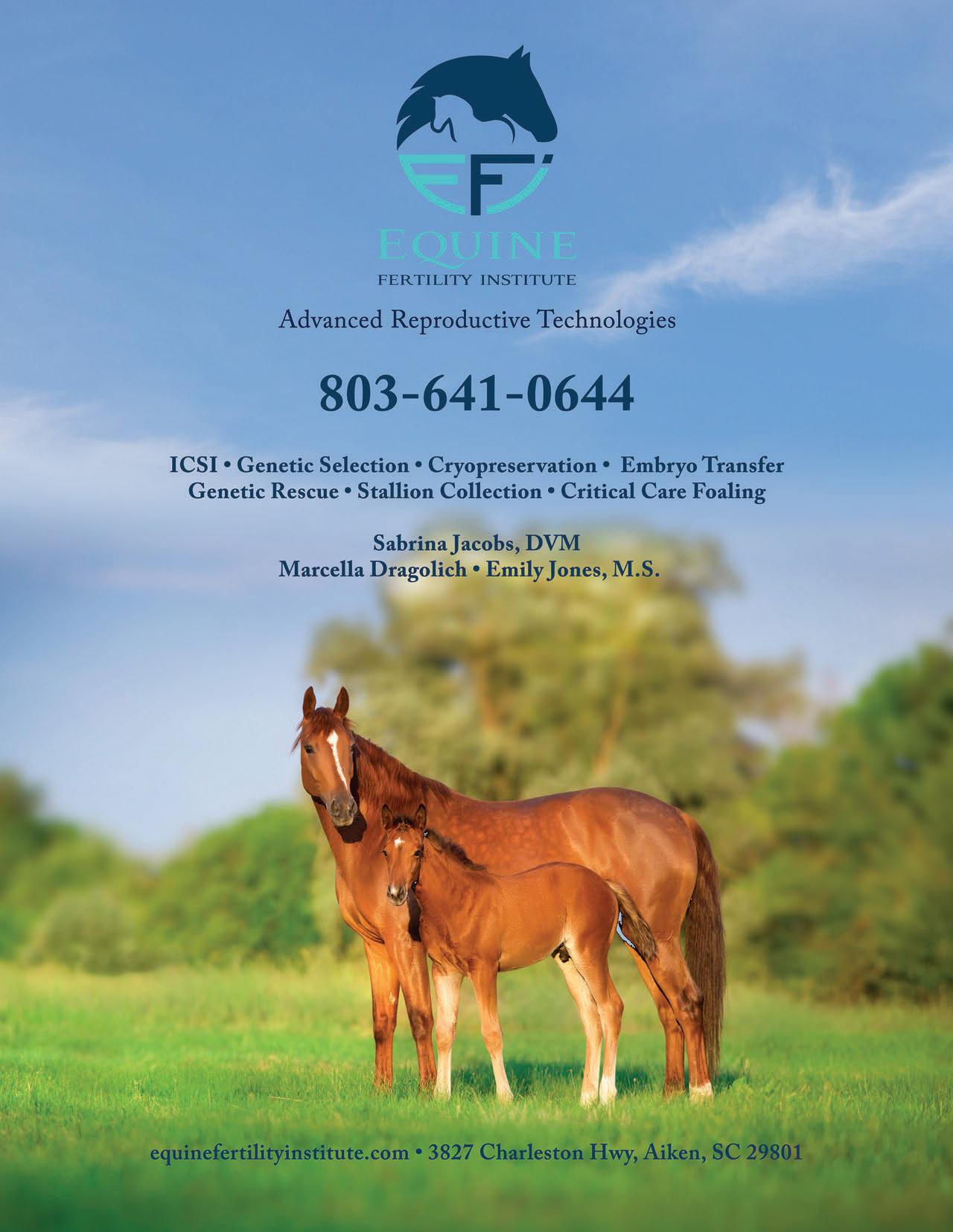










VicePresident,MeybohmRealtors
WORLDCLASS SPORTING& LUXURYPROPERTIES
LetDeirdreStokerVaillancourtwork foryoutofindtheidealhome,farm, seasonalequestrianfacilityor investmentpropertyforyouand yourfamily.Herrealestateexperience combinedwithvastknowledgeofAiken anditsmanyuniquelifestyle attractionsmakeshertheperfect combinationforyou!
Deirdrewillworkwithyoulongafter closingandensureherbelovedAiken becomesyourhometoo.
Embracetheluxuryequestrianlifestyle inAiken.
803.640.4591
deirdre@aikenscproperties.com www.aikenscproperties.com
DeirdreandhusbandMichelVaillancourt,theyoungestrider (andfirstCanadian)towinanindividualOlympicmedalin showjumping(Silver,1976.)MichelisalsoarenownedFEI level4showjumpingcoursedesigner.









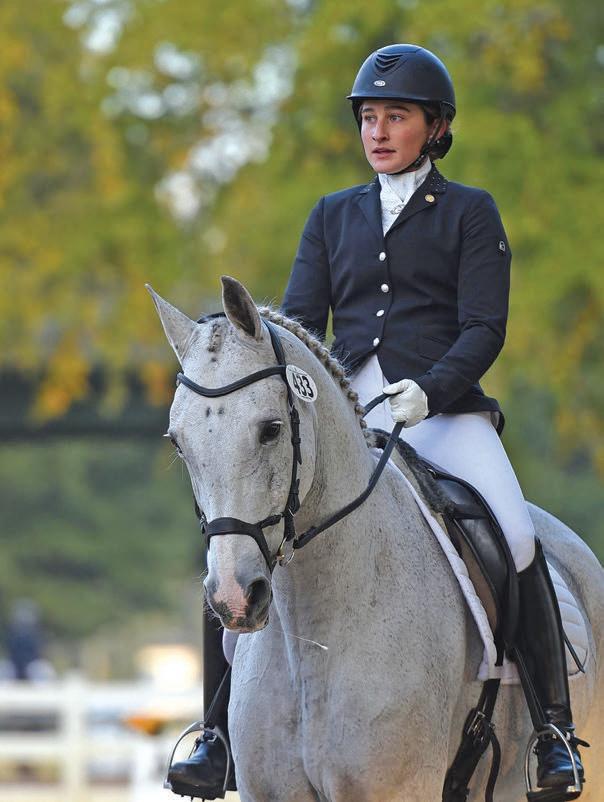





Editor
Lauren Allen
Publisher
Pam Gleason
Layout & Design Larchwood Productions
Contributors
Lauren Allen
Cassidy Brooke
Christina DeHaven
Allison Dunne
Pam Gleason
Gary Knoll
Bill Richert
Giana Terranova
Advertising
Lauren Allen
803-240-1275
Pam Gleason 803-643-9960
Ashley Haffey 607-743-1309
General Inquiries
Lauren Allen 803-240-1275
thecarolinasequestrian@gmail.com
Cover
Grace and Sarah Rabb with their horses
Jakino and Alpine's 3.14
Photography by Cassidy Brooke

Like us on Facebook:


The Carolinas Equestrian Magazine

Twitter: TheCarolinasEQ
Intragram: CarolinasEquestrianMag
Web: TheCarolinasEquestrian.com
Winter in the Carolinas has many benefits—the horses get a break from the bugs, riders can take full advantage of the marvelously sharp contrast of chilly air and warm sunshine, and equestrians of every stripe revel in the huge variety of horse sport accessible in the South.
This issue is focused on junior riders: We wanted to spotlight some of our area’s outstanding young riders from multiple disciplines, and elaborate on some of the opportunities that are available to them. We met a number of young riders who have demonstrated a serious commitment to their sports, and we only wish we could have introduced our readers to more of them. There are so many amazing kids who love horses!
“Equestrian 101” features a guide to some options for young riders, from riding for middle or high school students, to interscholastic, intercollegiate and National College

Equestrian Athletics. We compiled some of the basic information and detailed the wide variety of offerings in many different disciplines, from polo to eventing, to western, dressage, hunter/jumper and more. There are more possibilities out there than you might think.
In “Juniors Welcome: Foxhunting’s Next Generation” a very old tradition seeks to appeal to modern young riders. Susannah Pask interviewed representatives from multiple hunts across the Carolinas and describes how they are generating outreach through educational events and creating a variety of ways to participate, including reduced cost, or even free, memberships.
Our “Equestrian of the Carolinas” is a trainer who has introduced countless students to riding: Candi Cocks of Springdale Stables in Camden, S.C. Candi has a long history in the Camden area and has left an indelible mark on the many junior riders who first found a love for the equine in her program.
Artist and horsewoman Brooke Major originally hailed from the South, but now splits her time between America and France. Her paintings combine the representationalism of paint with the dimensionality of sculpture, as she uses palette knives to carve designs into a thick titanium oil composition built up on canvas, to play with “Shadow and Light.”
We hope you love these stories and pictures. Please reach out to us through our website at TheCarolinasEquestrian.com or on Facebook or Instagram and tell us about people we need to talk to, events we need to cover, or places we need to go see.
Lauren Allen Editor Grace and Sarah Rabb at the Aiken Horse Park
Grace and Sarah Rabb at the Aiken Horse Park
If the future of horse sports relies on young riders, then horsepeople in the Carolinas have plenty of reasons to be optimistic. Both North and South Carolina have a wealth of junior riders in all disciplines who are dedicated to horses and to their chosen sports. Not only are these young people accomplished riders, they are also true horsemen, devoted to learning everything about horses and committed to the happiness and well-being of their animals.
For this special edition of our regular Under 21 feature, we caught up with seven young equine enthusiasts from across the region to find out a little more about them. We met hunter/jumper riders, dressage students, a polo player, a halter horse conditioner and an event rider. Although these young people have diverse backgrounds and different dreams and goals, they are united in their love for horses, and they all display a particular sense of purpose along with the confidence that comes from interacting with horses. Especially in this day and age of computers, cell phones and social media, horses help kids meet goals, make friends and stay grounded, all while giving them wings.
Twins Emily Grace and Sarah Madelyn Rabb began taking riding lessons at the age of 6 at a barn near their home in Fort Mill, South Carolina. Their mother Lauren explained that Grace kept gravitating to horse toys and was not interested in dance or gymnastic lessons, and so Lauren asked if she would like to try horseback riding.
“At her very first lesson she was bitten in the stomach by a Shetland pony, but she absolutely loved riding and knew she wanted to continue. When we got home that evening, my husband Bryan asked Grace what she learned, to which Sarah replied ‘She learned not to mess with the Shetland ponies.’”
Sarah was initially terrified of horses but it wasn’t six months before she was riding, too. Within a few years, both Sarah and Grace began riding ponies and competing on the A show circuit and both earned top ribbons at USEF Pony Finals.
The girls began working with their current trainer, Alicia Wilkinson, in Indian Land, South Carolina when they were in middle school. With her guidance they moved up to show in the 3’3 and 3’6” equitation classes. Both Sarah
and Grace have qualified for and competed in the ASPCA Maclay Final, the USEF Medal Final and the USHJA Jumping Seat Medal Final for the last three years. They’ve also competed in the WEC Premier Equitation Cup, the Gladstone Cup and the South Carolina Governor’s Cup, where they’ve each been the Reserve Champion. Although they compete together in equitation, Grace also shows her horse Jakino, aka Jerry, in the Junior Jumpers and Sarah shows her horse Alpine’s 3.14 in the Junior Hunters.
Jerry is a barn favorite, and although he stands a whopping 17.3 hands, he recently carried a tiny beginner rider in the walk-trotcanter division. Jerry became a member of the Rabb family when Grace’s first equitation horse had to have colic surgery in 2021.
Alpine’s 3.14 or Pi as he is known, was bred by Alicia Wilkinson and named Pi because he was born on March 14, known as Pi day since 3.14 are the first digits of the mathematical symbol Pi. The Rabb family also owns an equitation horse named Kingdom Z, and a hunter named Lennox. The twins’ younger sister Lucy owns a 4-year-old recent import named Herkules that she shows in the Children’s Hunter division.
Owning and riding horses has had its share of challenges for the family over the years. In 2020, Pi had surgery on his right stifle after it was discovered that he had OCD, a developmental orthopedic problem that affects the bone and cartilage inside a joint. Sarah noticed that he was struggling even though he wasn’t clinically lame, and then managed his rehabilitation herself, with the help of her family, Statesville Equine Clinic and her barn family. Pi returned to competition the following year, qualifying and placing well at the Junior Hunter Finals in 2021 in Devon and in 2022 in Michigan.
Sarah and Grace are both committed to attending the University of South Carolina in the upcoming year, where they will ride on the Division 1 NCAA Equestrian Team coached by Boo Major and Kristen Terebesi. They also plan to continue showing their own horses through the end of their last junior year. Sarah plans to major in biology on a pre-veterinary


track to potentially become a small animal vet. Grace plans to major in nursing. Grace explains her career choice “I really like people. I like teamwork and I just love to be around people.” Then Sarah pipes up “I am the opposite. It sounds cliché, but I just really love animals. And I am also really interested in science.”
The girls maintained a very high standard academically in high school, ranking in the top 15% of their class of nearly 500 at Fort Mill High School, but they acknowledge that it has been a challenge to balance it all, particularly with needing to travel to shows while attending a public high school with strict attendance requirements.
“We thank every horse the girls have ever ridden, and there have been a lot, for teaching the girls to be confident, yet humble” says their mother. “They have learned to be balanced, in life and on a horse. Most importantly they have found joy in celebrating the victories, supporting each other, and the value of hard work.”
AskJosh Escapite what he likes about polo and his answer is straightforward.
“Everything,” he says. “It makes every other sport feel boring.”
Josh, who is 17 and a senior at Aiken South High School in Aiken, South Carolina, started playing polo about eight years ago with Aiken Youth Polo (AYP). He is a member of the AYP Open Interscholastic Polo Team, plays regularly in the United States Polo Association National Youth Tournament Series (NYTS) league and is an increasingly sought-after player in the Aiken area where he plays with and against adults. Josh’s success speaks for itself: He has been on the winning team of the USPA Southeast Open Interscholastic Regionals; the runner up in the Open Interscholastic National Finals; and a NYTS Finalist, All Star and Most Valuable Player. He says that the highlight of his career so far was the Copa de Plata 8-goal at New Bridge Polo Club in November 2022 in which he played with the LBL team. Not only did his team win the final in an 11-10 squeaker, Josh was named the MVP.
Josh’s mother, Dr. Sarah Thompson, is an amateur hunter/jumper rider and an equine veterinarian with Southern Equine Services in Aiken. She says that Josh was not very interested in riding until he started in polo, but now horses and playing dominate his life. He rides every day and plays three or four times a week during the season. His string consists of 10 horses, most of them given to him by professional players who recognize his talent and dedication.
“They also like to give him horses because he’s a nice rider and good with his hands,” says Dr. Thompson. “They know the horse will be well treated.”
Josh plans to attend University of South Carolina Aiken next year where he will play on the intercollegiate polo team. Tiger Kneece, who runs Aiken Youth Polo and is also the coach at USC Aiken, is counting on Josh’s talents.
“Josh was one of our original players when we started Aiken Youth Polo. He’s stuck with it, and now he helps us with the younger kids in the polo school,” says Tiger. “It’s nice to see him really coming into his own.”

Kiara Lutzen, who has been riding since age 9, took to dressage because she likes how complicated it is. “Whenever you get those perfect moments, it can be so fun,” she said. A 17-year-old high-school senior from Summerville, South Carolina, Kiara has been successful with her 14-year-old Hanoverian bay gelding Van Halen, whom she got about four years ago.
Kiara switched to dressage from eventing after, as she put it, falling off her pony a lot. One fall resulted in Kiara sustaining a lacerated kidney. Her pony was then diagnosed with kissing spines, a skeletal defect of the back, which explained his being uncomfortable. When she started dressage lessons, Kiara said she really liked learning the basics and has been a fan and successful competitor ever since. Kiara says it’s the escape from reality that she enjoys the most about the horse world.
Kiara trains with Laurens Bissell at Middleton Place Equestrian Center in
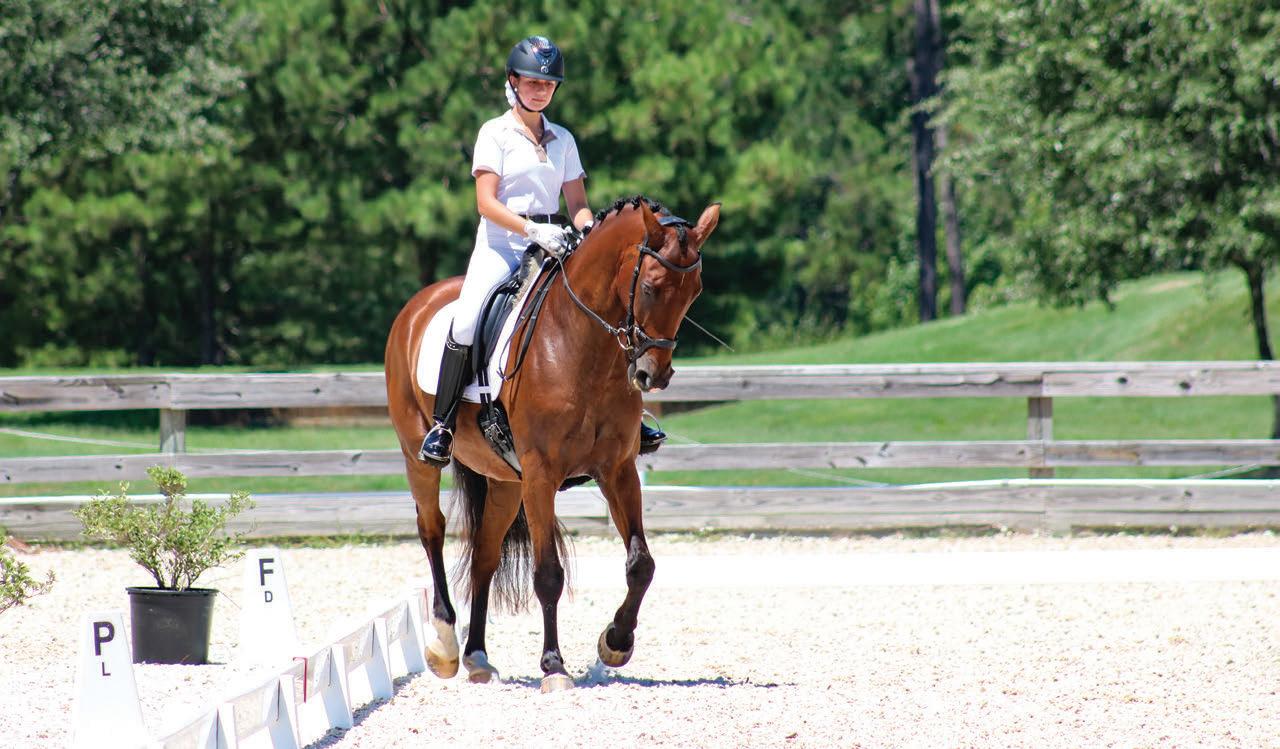
Charleston, South Carolina, and enjoys spending time with her good friend Georgia Dempsey, also a high-school senior who trains there. They enjoy watching each other at competitions and have lots of fun together.
Laurens says the girls jump for fun once in a while. “I wanted really well-rounded horsewoman,” said Laurens, who enjoys teaching both teenagers. She appreciates that they put the horse first: “There’s not a lot of ego involved.”
Kiara says her greatest accomplishments include moving up the U.S. Dressage Federation levels. She earned a USDF Bronze Medal in 2022 and has placed at the USDF Region 3 Dressage Championships.
Next year Kiara will attend Charleston Southern University to pursue a business degree, with the goal of eventually taking over Lutzen Construction, her family’s business. She plans to continue training with Laurens while in college and ride at least four times a week, with her sights set on reaching the Grand Prix level.
High-school senior Georgia Dempsey earned her U.S. Dressage Federation Bronze Medal in November 2022. “I never thought I’d achieve this,” she said. Georgia who has placed at USDF Region 3 Dressage Championships, also qualified for the U.S. Dressage Finals in 2021 and 2022, although she did not enter.
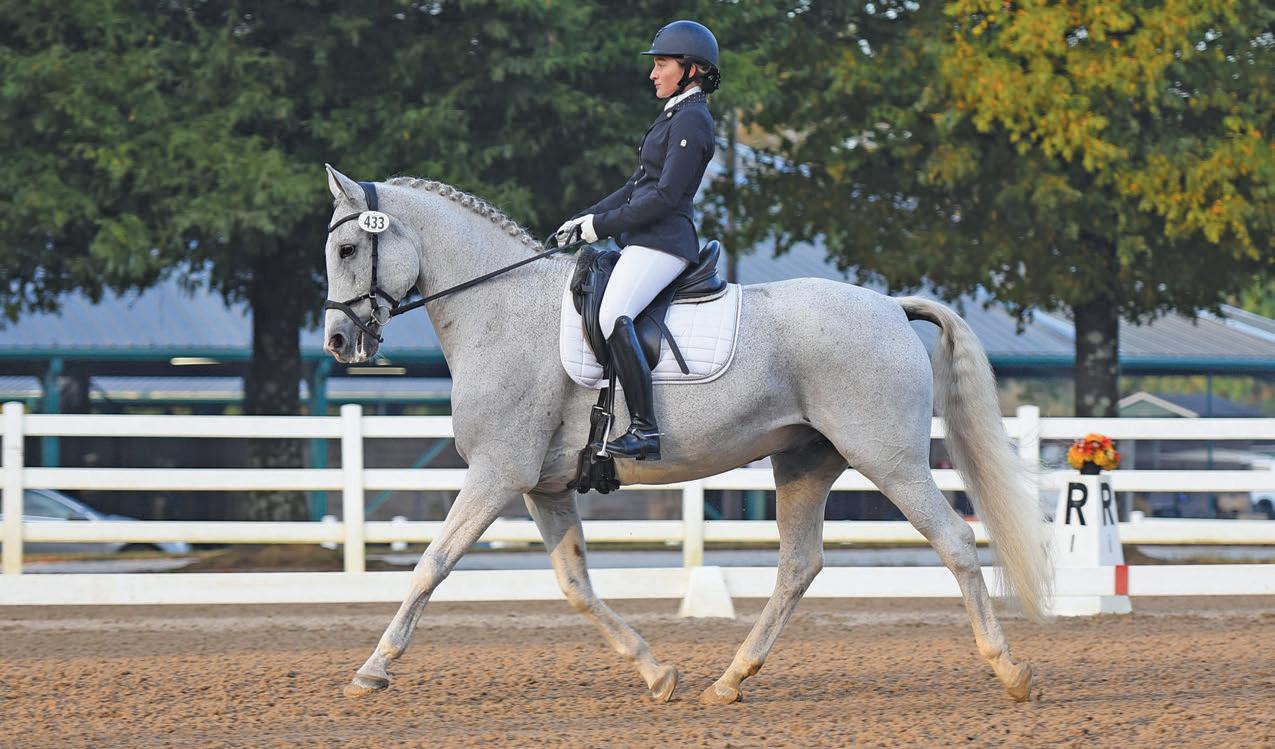
Georgia, who lives in Charleston, South Carolina, has been riding with her current trainer, Laurens Bissell, since she was 7. “She’s like my second mother,” said Georgia. They train out of Bissell’s home base, Middleton Place Equestrian Center in Charleston, and Georgia has been riding her trainer's Oldenburg gelding Rhodium for the past year and a half.
Georgia says she enjoys the mental aspect of dressage. “I like the ability to dissect each piece, whether it’s a test or a movement.”
An only child, Georgia was born into an animal-loving family: both her parents work in veterinary medicine. Her mother rode, and Georgia recalls first sitting on a horse bareback
around age 3. Now 18, Georgia says her biggest accomplishments are being awarded the Bronze Medal and achieving her self-imposed goal of competing a Third Level class before graduating from high school. Yet she views learning a movement at home just as important. “I didn’t know I could passage and piaffe,” Georgia said.
Georgia was glad to lose the title of the only rider under age 21 at the Middleton Place barn about six years ago, when Kiara Lutzen, also a high-school senior, began to ride with Laurens. The two are best friends. While they take lessons separately, Georgia says they’ll go on a trail ride or ride in the field once a week to catch up on each other’s lives, horses included.
Georgia is headed to college in the fall, and says she will relegate riding to a hobby when she has time. After riding at least three times a week since age 7, she plans to ride during college breaks and sees herself reconnecting with riding more consistently after college.
“I know I’ll end up back in it because I’ll miss it so much,” she said.
who trained Trent for that World Show in 2018, and the show took place just a month before Gene died.
In addition to Cinderella Style, who is now 6 years old, Trent is showing another mare, Heart of Dixie, who just turned 3. Then there’s the mare Secret Keepsake, who Trent describes as super sweet and who he took to the World Equestrian Center in Ocala at the beginning of January, where he won the Youth 2-yearold Mare class. Trent also won the Youth Aged Mares class there with Cinderella Style.
Trent Parker is growing up immersed in the Quarter Horse world. At age 14, he already has numerous accomplishments. He considers his greatest achievement thus far winning the Reserve World Championship at the American Quarter Horse Youth Association (AQHYA) World Show, in Oklahoma City, Oklahoma. Trent shows in the halter division, and he handled his family’s mare, Cinderella Style, to this honor in 2018, when he was just 10 years old, the minimum age for AQHYA exhibitors.


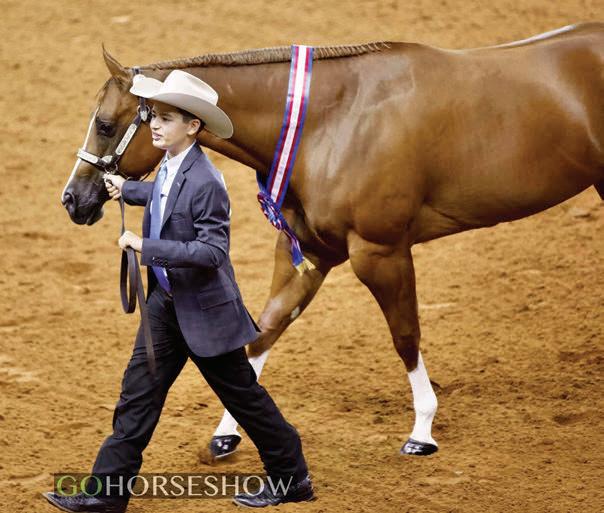
Trent lives in Virginia Beach, Virginia, but all the Quarter Horse magic happens at the family’s Gene Parker Farms in Orrum, North Carolina. Gene was Trent’s grandfather, and he was a renowned breeder, trainer and judge, as well as an inductee into the North Carolina Quarter Horse Hall of Fame. Gene was a great inspiration for Trent. In fact, it was Gene
“I really like how easy it is to bond with the horses,” Trent said, when asked what he likes about the halter discipline.
Trent trains with his father, Kyle Parker, who also shows, as well as with his coach Jeffrey Pait, owner of Pait Show Horses in Aiken, South Carolina.
While his grandfather taught him to ride western pleasure, Trent prefers to continue showing in halter. In the long term, he wants to carry on the legacy of his grandfather. “I saw my grandfather show and I wanted to get into the business,” said Trent. “Everyone knew him and he was such an impactful person.”

Dylan Philipps, 18, was practically born riding. Her parents, Meredith and Chris Philipps, own and operate New Beginnings Farm in Pittsboro, North Carolina.

“We always joked that my mom rode pregnant and I think I was at the barn the same day I came home from the hospital, so I got a really early start.” Dylan rode throughout her childhood, and began taking dressage lessons on a Shetland pony named Rusty when she was 5. At 7, she joined the local Pony Club and jumped for the first time. Then there was no looking back. She began training with the Pony Club instructor and completed her first horse trial at Denny Emerson’s Tamarack Farm when she was around 8.
Dylan is currently in her second semester at North Carolina State on a full academic scholarship, majoring in business administration with a concentration in entrepreneurship. She discovered her aptitude for business when her father asked her to redo the farm’s website, and by teaching riding lessons and organizing summer camp during a forced vacation after she broke her foot in a riding accident.
Dylan's horse, FVF Top Gun, aka Maverick, is a coming 10-year old Dutch Warmblood that she found practically in her own backyard after searching up and down the East Coast.
“He’s by far the nicest horse I’ve ever sat on. I think he has all the potential in the world, so I just keep training and trying to be good enough to ride him, and see where that takes us,” says Philipps, who recently participated in the United States Eventing Association Emerging Athlete Under 21 clinic with David O’Connor in Florida. Maverick was bred in North Carolina by Laura Gaither Ulrich at Fox View Farm, and was being developed for the jumper ring until Gaither Ulrich’s pregnancy prompted her to sell.
Dylan is not sure if she will turn professional after college, but she will continue to event.
“I am really inspired by some of the amateurs who compete at the 4-star and 5-star levels. I absolutely have the ambitions to get to the top level of the sport, but I’m not sure in what capacity, whether that will be as a pro or maybe working in the corporate world and having one or two really nice horses going.”





Candi Cocks, owner of Springdale Stables in Camden, South Carolina has probably introduced 5,000 kids to riding horses: If you figure about 100 students a year, this is likely a conservative estimate. She started her program in 1975 and some of her riders now are the children of previous students.
“One of the parents today said ‘I want to get back to riding’ so I said, ‘Come on! We take adults, too.’"
“Growing up, I was infatuated with horses. My parents didn’t have any horses; my sister didn’t; I was just born with it,” she said. “It was kind of my father’s and my dream to run a horse business together. And he retired out of the Army the same year I graduated from college.”
Candi’s father was Colonel Leslie Meckstroth, who served as the Fort Jackson Army Post veterinarian during the time Candi was in high school, in Columbia, S.C. “I took riding lessons at Lake Murray and we foxhunted. We would drive up I-20 (actually I-20 wasn’t even completed yet, this was back in 1968, ’69) and we would bring the horses up and we foxhunted from the barn where Springdale Stables is now. It used to be the Hunter Barn – a 24-stall barn, with kennels and the riding ring with a little white rail around it.”
you think I had something to do with that! It’s the same with the kids; they’ve never ridden before and you get them to the point that they’re showing and winning, and there’s just a lot of satisfaction in that.
“It’s the same with the kids; they’ve never ridden before and you get them to the point that they’re showing and winning, and there’s just a lot of satisfaction in that.”
“I stay low key,” she continued. “I don’t go the big A shows. I don’t have the fancy horses. I try to cater to some of the riders that wouldn’t have that opportunity. I have 10 horses of my own, and I use them all in lessons. The biggest change over the years – even at the state level shows – it’s gotten so competitive. That’s why we developed the Camden Equine Circuit, because the lesson kids can be competitive there. I seem to remember in the past my students and horses could go to the Equine Park and be competitive. But children are getting nicer horses. And now I find that once the riders get past that 2’3” level, they move on. They either quit riding or they get their own horses. But it used to be I would have kids all the way through high school. They don’t seem to stick with it as long now, and let’s face it, society has changed. Kids start getting phones and they just don’t do outside activities as much.
By the time Candi and her father purchased the barn it had been converted into a home along with 12 stalls. “We moved down to Camden and I taught school from 1976-80 and I did riding lessons in the afternoon. Then I galloped racehorses in the mornings and taught in the afternoons. Then I got too old and brittle to gallop, but I did that for 30 years.
“I like teaching kids. It’s kind of like with the racehorses: you break the babies; they’ve never had a saddle on their back or a rider or anything, and you get to see them progress and race, and
“I had a mini stroke about a year and a half ago, and I made a decision that the barn does not run my life. I mean, coming from racehorses, you go 24/7 no matter what, and I sat back and thought, I want to do some things in my life besides horses. I joined a book club at the library. That’s out of my comfort zone, and I enjoy it! I am 69, not a spring chicken anymore.”
As far as retirement, however, Candi has no plans for shutting down. Financially, she says the continually rising prices for feed and shavings has been very hard to manage. “Sometimes I get frustrated and I think, ‘just sell this place.’ But I love it here, and I love what I am doing. I am not ready to give it up yet.”


• World-class equestrian center
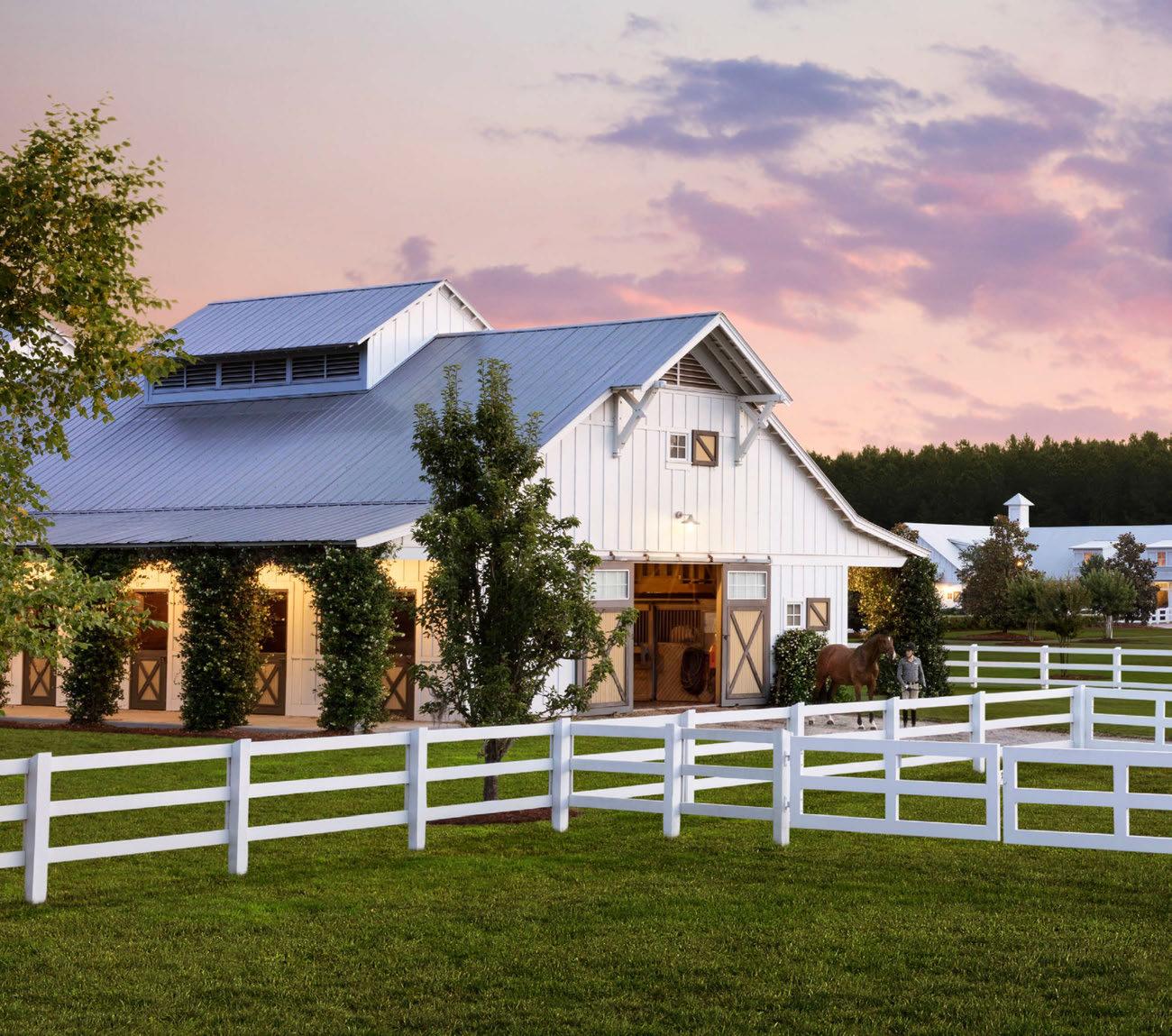
• Exceptional equestrian studies program
• National championship team
Your future is bright at SCAD.
To learn more about SCAD equestrian or explore other award-winning programs, visit scad.edu or email admission@scad.edu.
Students at the Savannah College of Art and Design (SCAD) had an unprecedented opportunity this year: the chance to design a jump for the ASPCA Medal Finals at the National Horse Show in Kentucky.

For junior equitation riders, the ASPCA Maclay Finals is the pinnacle of the sport. Every year, hunt seat riders all over the country compete for the honor to qualify. They must earn enough points to attend the Regionals and then the best of them move on to the Finals to vie for supremacy on the first weekend of November. The class is a spectacle of immaculately groomed and exceptionally well-trained horses being ridden over a demanding course of obstacles.
The Maclay course designer, Bobby Murphy, has collaboratively developed new and instantly iconic fences for the competition for years. In
the spring of 2022, Murphy spoke online with students at the Hardeeville, S.C. campus of the SCAD Equestrian Center. He Zoomed with a class on competition design, taught by Ahna Phelps, Associate Chair of Equestrian Studies.
Murphy set a design challenge for the students: an opportunity to submit a jump to be used in the finals. In equitation, the obstacles are set by the course designer to test horses and riders in many ways. The jumps can present difficulties because of where they are placed; because of their relationship and distance to and from each other; for their width (the narrower a jump is, the more precisely the rider must guide the horse); and for their appearance. A jump can be inviting or terrifying from the horse’s perspective; but at the finals the jumps are always dressed to impress.
Ahna Phelps was delighted with the experience for her students. “Since we are an art and design university, it was so fun for the equestrian students to get to apply concepts like theory of design and use of color, and to see these being used in a way that related to their equestrian interest, and then to see the horses actually jumping over the jumps that they designed, was just very rewarding.”
Three jump designs were ultimately selected for construction: an ivy-covered staircase by Savannah McCants, inspired by the elegant SCAD campus; a white wall made of letters spelling MACLAY by Madison Aguilar; and an airy, tripod vertical with stone column standards by Morgan Henson.
Madison Aguilar’s Maclay wall of letters was declared the winner of the design challenge. “It was such a big opportunity as a student. As a junior rider I was never able to qualify and

go to the Maclay Finals but this was a way I could participate.” Aguilar, a senior this year, actually designed eight jumps, two relating to the landmark Savannah Bridge, one with an oak tree theme, and several others inspired by buildings on campus. “I didn’t realize what a big deal it would end up being. I thought [Murphy] would just pick a jump and it would be there at the show, but he went above and beyond and made sure that credit was given to us and to our school, which was really amazing.
“The program at SCAD introduces you to every aspect of the horse industry, from feet and shoeing to anatomy and lameness, to business and competition design,” Aguilar continued. “My favorite classes were a conformation class that really helped me know what to look for in a prospect, and the competition design class which gave me an appreciation for how much work is put into the shows that we go to.”








 Story by Susannah Pask
Photography by Pam Gleason & Bill Richert
The Aiken Hounds Children's Hunt in the Hitchcock Woods, January 2023
Story by Susannah Pask
Photography by Pam Gleason & Bill Richert
The Aiken Hounds Children's Hunt in the Hitchcock Woods, January 2023

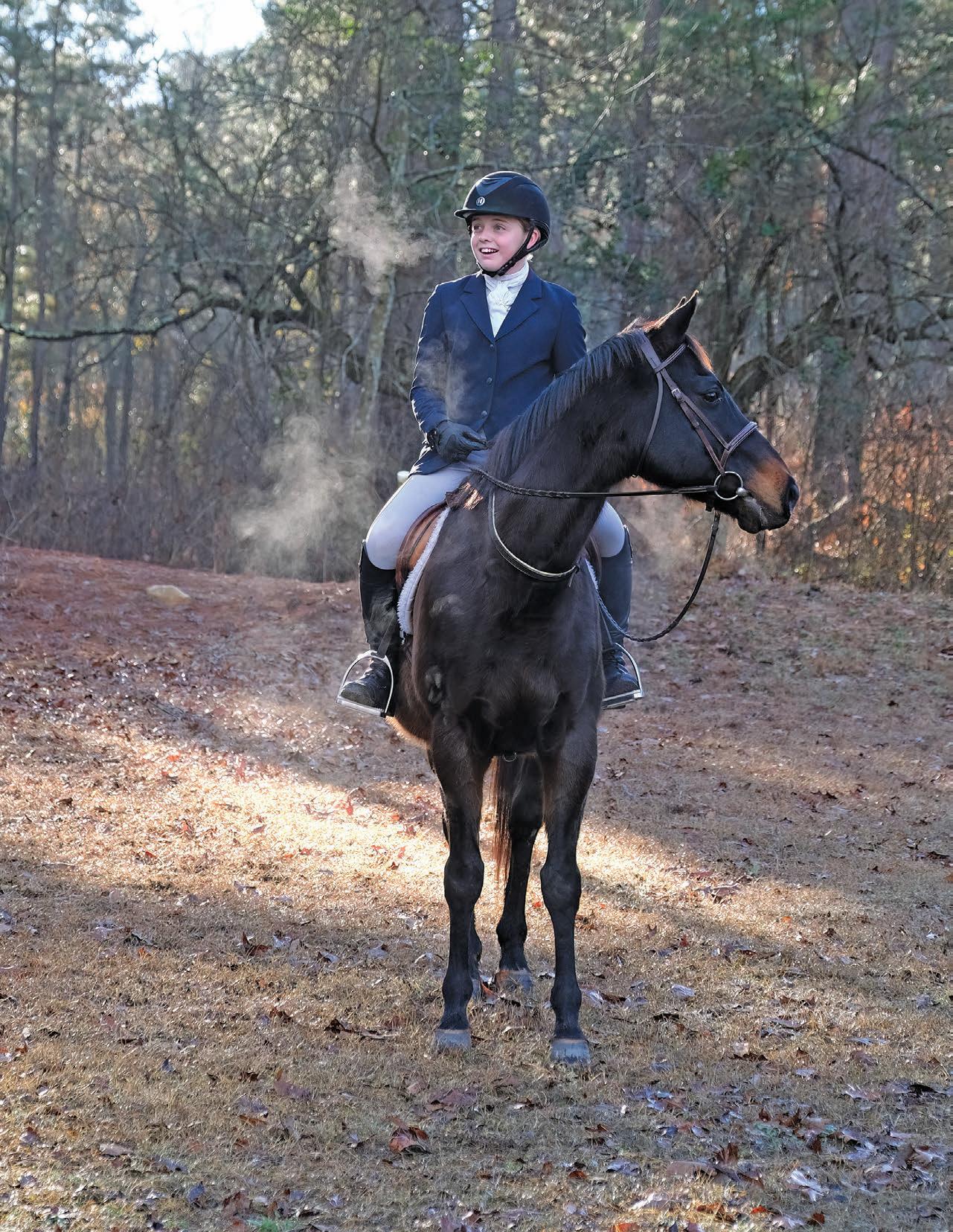 Ella Harris before the Aiken Hounds Children's Hunt
Pam Gleason
Ella Harris before the Aiken Hounds Children's Hunt
Pam Gleason
It is a cry that has echoed across the centuries, indicating that a fox has been sighted by the huntsman. And then the field is off in pursuit. But how long will this deeply traditional sport be around?
Foxhunting originated in England and is said to date to 1534, when a Norfolk farmer used his hounds to chase a fox off his property. Foxes back then were considered vermin and were hunted to prevent attacks on chickens and other farm animals. It wasn’t until the 18th century that foxhunting developed into a sport in its own right. The oldest running foxhunt is the Bilsdale Hunt in Yorkshire, England, which was established in 1668 by George Villiers, the Duke of Buckingham.
Hunting live foxes was banned in the United Kingdom in 2004, though it remains permitted in many other places. Drag foxhunts still flourish in England and in the U.S. This is a type of hunt where human “foxes” lay a trail of synthetic fox scent on multiple lines through
the woods and fields for the hounds to follow to final destination, where they are rewarded with treats. Drag hunts preserve the traditions and the pageantry of the sport without the need for a fox or a coyote, but even in live hunts, the quarry is rarely caught.
Here in the Carolinas, foxhunting is alive and well and a new generation of foxhunting enthusiasts has taken the field. Thanks to dedicated hunt staff and supporters from hunts across North and South Carolina, there are outstanding educational programs and events designed to teach young riders about the sport. Young riders learn how to prepare their horses and themselves for an exhilarating day of riding and develop new skills negotiating varied terrain outside of the ring.
Aiken, South Carolina is home to several recognized hunts. The Aiken Hounds, the oldest hunt in the state, was founded as a drag hunt in 1914 and has been hunting in the Hitchcock Woods ever since. Hitchcock Woods is the largest

privately owned urban forest in the country, spanning 2,100 pristine acres with miles of trails punctuated by many lines of Aiken fences.

Larry Byers, the Joint Master of Aiken Hounds, was formerly the president of the United States Pony Club, so he has special experience with junior riders. Aiken has three dedicated children’s meets each season. Junior riders team up with members of the hunt staff and they learn what each staff member does. Aiken Hounds also trains a junior whipper-in each year to fill the position on a regular basis. Other programs include mock hunts and visits to the kennels where juniors bathe the hounds before the formal Thanksgiving Opening Meet and Blessing of the Hounds.
Purchasing the clothing required for hunting can be expensive, so the Aiken Hounds collects hunt clothes from juniors who have outgrown them to donate to younger, smaller riders. The Aiken Hounds Foundation, formed five years ago, is dedicated to the conservation of land and to the education of junior riders, both critical to the preservation of the sport.
Whiskey Road Foxhounds, another hunt based in Aiken, recently hosted 12 young riders from the International Pony Club Exchange. The pony clubbers came from England and Ireland and were lent horses by members of WRFH. It was a successful day for all. Betsy Minton, who is joint master of WRFH says, “Sharing our sport with young, talented, enthusiastic riders is the way to go – and the best way to secure the future of foxhunting.”
The Camden Hunt, the second oldest hunt in South Carolina, introduced its junior foxhunting program in the summer of 2021. This consisted of three separate clinics. The first was an informal introduction to foxhunting by Boo Major, the head coach of the University of South Carolina equestrian team, who spoke to parents and children, instilling confidence and interest in the sport. The second clinic featured two former Masters of Foxhounds, who showed the juniors examples of the necessary clothing, tack and other special foxhunting accessories, and explained the traditions and etiquette of the sport. The third clinic was on horseback, starting in a ring, then moving into the woods to give the juniors a feel for an actual hunt. Juniors who were already good riders were taken out cantering and jumping with a group where they learned the hunting ground rules.

The Camden Hunt has also established a library of hunting books that the children are invited to borrow. The hunt has put on a braiding clinic, so juniors can learn how to braid correctly for hunting, which is different than braiding for hunter/jumper shows. Finally, Camden welcomes juniors with a special subscription for riders 18 and under, allowing them unlimited riding in hunt country, and to attend all cubbing, formal season meets and social events. Says Janet Butcher, joint master of Camden Hounds, “We love juniors!”
Green Creek Hounds in Polk County, N.C. always welcomes juniors interested in hunting. Junior riders hunt with no cap fee
on an unlimited basis, with arrangements for an experienced member to accompany them. Additionally, Green Creek offers a free, “Come as you are” hunt in October, where turnout requirements are dropped, except for helmets and hard soled shoes.
The Tryon Hounds in North Carolina encourages juniors by offering free memberships and free capping. They also host a qualifier for the Junior National Field Hunter Trials every year. Tryon’s huntsman, Beth Blackwell, runs a summer kids’ clinic where she introduces juniors to hunting and prepares them to join the hunt field. Tryon has a hound rehoming program called Homeward Hounds where juniors are encouraged to come to the kennels to help get the hounds ready for adoption. They also help hunt staff with local hound shows. Tryon has a half dozen junior members, several of whom hunt regularly. One of them has done so well that she is now their junior huntsman.
According to Lea Edwards who is the Master of Foxhounds at Wateree Hounds in the Camden S.C. area, “We usually do a day with juniors the beginning of our season, and also hold foxhunting camps which are well attended. This past fall we worked directly with the Palmetto Pony Club and had a mounted introduction, which exposed young riders from all disciplines to the unique experience of foxhunting.
Wateree’s junior meet enables juniors to ride with the field masters in the front of each field. Our tally-ho wagon carries parents to view the foxhunt as it unfolds. Last year we had 22 junior riders participate on this day.”



From clinics, educational events, mock hunts, free capping and interaction with hounds, hunting in the Carolinas for juniors has never been easier or more enjoyable.
If you want to find out what foxhunting is all about, contact your local hunt to find out what they offer. Tally-Ho!



Did you know that students can compete in horse shows without owning a horse? Did you have any idea that athletes could “letter” in equestrian sport? Would you believe that some young people earn college scholarships for riding competitively?

There are many equestrian opportunities for riders of every stripe, from western to dressage to hunter/jumper, and across all levels. These include organized competitions for individuals and teams at the middle school, high school and college level. Some institutions are renowned for their equestrian programs, allowing horse enthusiasts to combine their riding passion with their academic education without compromising either. Even schools that do not have a strong equestrian tradition may have a surprising array of outstanding equestrian offerings.
The following is a brief guide to the variety of ways students can combine horse sports with academic pursuits.
Right: Celia Cram, 2022 winner of the ANRC National Equitation Championship for collegiate riders, With SCAD coach Ashley Henry and assistant Tatum Tatreau. Photography by Giana Terranova

The Interscholastic Equestrian Association (IEA) is a nonprofit organization that oversees horse shows for students from grades 4-12, in both a team and an individual format. The IEA focuses on three disciplines: western, hunt seat, and dressage. Host teams supply all the horses and tack, creating a more level playing field by eliminating the financial burden of horse ownership. Competitors are allowed to warm up only very briefly to familiarize themselves with their mounts before going into the ring.
An IEA team can be formed by a coach and three or more riders, in either middle school or high school. The team must have access to an equine facility with horses and practice areas. Teams can be affiliated with a school, or they can be open to qualifying equestrians within the area.
Lynne Conto, who lives in Camden, South Carolina, is one of the coaches of the Central Carolina Equestrian Team, a public team not affiliated with any individual school and open to any qualifying riders. Conto also travels to other
farms to introduce the IEA concept to riders and to put together mock shows in preparation for IEA events.
“One awesome thing about IEA is that it promotes teamwork between the riders. Instead of just competing against other riders, IEA provides close bonds between riders on the same team,” according to Conto. “Riders have a chance to ride a variety of horses, giving them valuable horsemanship experience. It is a perfect way for riders to prepare for the IHSA and/or NCAA college level programs.”
For more information or to find a team near you, go to www.rideiea.org and find your discipline, then click “find a team” to see maps and contact information for teams in your area. The South Carolina Independent Schools Association (SCISA) and North Carolina Independent Schools Athletic Association (NCISAA) also offer equestrian sport to participating independent private schools, sometimes alongside or within the structure of the IEA.
The Intercollegiate Horse Shows Association (IHSA) is a nonprofit that sanctions equestrian competition at more than 400 member colleges and universities. Riders of all levels compete in both individual and team competition in hunt seat, western horsemanship, ranch riding and reining.

Horses at IHSA shows are furnished by host colleges and are chosen by draw. Divisions range from beginner to open, and riders may qualify for Regional, Zone and National competition. The Aiken-based hunter/jumper rider Celia Cram, for instance, elected to attend the Savannah College of Art and Design (SCAD) and to ride on their IHSA team because she plans to make a career with horses.
“The equestrian studies major was a great option for me so I can further my knowledge as a developing professional. The team at SCAD is
great and I think they have a system that works. Ashley Henry, the head coach, is so dedicated to her students and their success, individually and as a team.”
In IHSA competition, exhibitors must ride the horse in the tack provided, and they are not allowed to do more than walk during their warmup before they enter the ring. Celia Cram grew up riding a wide variety of different horses, catch riding and showing sales horses at her parents’ Highfields Equestrian.
“That has given me the ability to get on whatever horse I draw and jump a full course with no warmup. I really enjoy being on the team and in the equestrian studies program where I learn something new every day. You never stop learning when you work with horses, so I felt I needed to soak up as much knowledge as I could before I went out on my own.”
Giana TerranovaThe National Collegiate Athletic Association (NCAA) sponsors equestrian sport as an “emerging sport for women.” To date, there are fewer than 30 schools in the country that have NCAA equestrian programs, included among them, the University of South Carolina (Columbia) and the College of Charleston. The National Collegiate Equestrian Association (NCEA) is the governing body for NCAA Division Equestrian Teams.
NCEA competition includes four disciplines: Jumping Seat Flat, Jumping Seat Fences, Western Horsemanship and Reining. Teams compete in a head-to-head format: Each pair of riders from opposite teams competes on the same horse, in the same tack. The rider with the highest score from the judge earns the point for her team. The level of riding in each discipline is advanced. According to the University of South Carolina head coach Boo Major, USC looks for riders with experience in the Big Eq at 3’6” but also considers riders at the 3’3” level.
“We are also always looking for prospects that have very good flat knowledge, which is sometimes missing in today’s equitation riders. In Western we look for riders with AQHA or

equivalent horsemanship experience. Reiners need to have extensive experience in the NRHA.” Major elaborates, “You always want a sense of family on a team. The ability to adapt to any horse in a short period of time is crucial to anyone’s success in NCAA riding, but also being a team player, hard worker, good time manager, good grades and a willingness to adapt are all a must on our team.”
For more information about NCEA teams and to see which schools offer equestrian sport at this level, go to collegiateequestrian.com
The Intercollegiate Dressage Association (IDA) is modeled on the IHSA format. College teams and individuals compete against one another at USDF Introductory through First Level as well as in Dressage Seat and the Quiz Challenge. As in the IHSA, the host team provides the horses, “which adds to the challenge and the sportsmanship of the competition.” The IDA is a growing organization: teams across the country participate in regional shows, leading up to the national finals in April. (Teamdressage.com)
Intercollegiate eventing is relatively new: the United States Eventing Association established a college division in 2014. In intercollegiate eventing, riders compete on their own horses at various regional horse trials that have agreed to hold an Intercollegiate Team Challenge. The riders self-identify to the competition organizer as members of a team, and each individual’s score is added up to arrive at a team score. The season culminates with the USEA Intercollegiate Eventing Championships.
Intercollegiate eventing has a rapidly growing following in the Southeast, with teams at USC Aiken and Columbia, Clemson and NC State among others. Clemson even won the national championship in 2017
Polo is the oldest intercollegiate equestrian sport, with the earliest matches held during the first decade of the 20th century; the United States Polo Association Intercollegiate Championship started in 1922. Today there are
41 colleges and universities with polo teams, and a growing number of high school and middle school teams as well, which compete for the USPA’s interscholastic and middle school championships.

Currently, Aiken Youth Polo has the only high school and middle school polo program in the Carolinas, and it is very successful. Under the tutelage of the former 7-goal player Tiger Kneece, Aiken’s teams have been dominant on a national level, especially in the girls’ division, where they are the reigning two-time national champions. Tiger also coaches the USC Aiken intercollegiate team.
Intercollegiate and interscholastic (I/I) polo relies on host teams to provide all the horses, which are played on a split-string basis, each pony playing one chukker for each team. Games are played three to a side in an arena. I/I polo has proven to be one of the best ways to introduce new players to the sport, second only to being born into a polo family. (Aiken Youth Polo on Facebook or visit uspolo.org)
College rodeo is huge in the Western part of the country, particularly in Texas, but it is nowhere near as big on the East Coast. In fact,
the only Carolinas institution with a National Intercollegiate Rodeo Association team is Erskine College in Due West, S.C.
High school rodeo, on the other hand, is healthy in both North and South Carolina, both of which have high school and junior high associations. The National High School Rodeo Association sanctions over 1,800 rodeos each year and sponsors two elite youth rodeo events: the National Junior High School Finals Rodeo and and the National High School Finals Rodeo, which bills itself as the “World’s Largest Rodeo,” having approximately 1,500 contestants who compete for buckles, title and thousands of dollars in scholarship money. (NHSRSA.com)
Equestrian athletes interested in lettering in their chosen sport can do so through the US Equestrian Interscholastic Athlete Program available through US Equestrian (USEF.) Students must be subscribers or competition members of USEF and can earn an Interscholastic Athlete Varsity patch and a pin for completing a minimum of 100 hours of training, or by participating in three USEF or non/USEF competitions of any level. You can also earn a varsity letter in polo from the USPA.
Some individual colleges and universities offer scholarships for equestrian athletes in various disciplines. These range from a small check that might help buy books, all the way up to a full ride for four years.
There are also a number of other organizations that give grants to students who ride. For instance, the Intercollegiate Equestrian Foundation (IEF) awards multiple scholarships each year. IHSA students can earn scholarships for demonstrating a passion for equestrian sport, a commitment to excellence, financial need and even for their horsemanship knowledge. For more information visit www.IHSAInc.com
The United States Polo Association gives out a number of $4,000 scholarships each year to interscholastic players who wish to continue to play in college and these may be renewed each year for four years.
Young riders in the western sports can apply for a multitude of scholarships. The American Quarter Horse Association (AQHA), the National Cutting Horse Association (NCHA)
and the National Reining Horse Association (NRHA) all offer grants that can be used for a college or trade school. Additionally, there are some generous scholarships for rodeo sponsored by various organizations, including the ProRodeo Hall of Fame and the Professional Rodeo Cowboys Association.
Whether through providing opportunities for competition, fostering team spirit, introducing a new discipline, or contributing financial support, a love of horses can be very beneficial for a high school or college student. Horses and education: they go together.


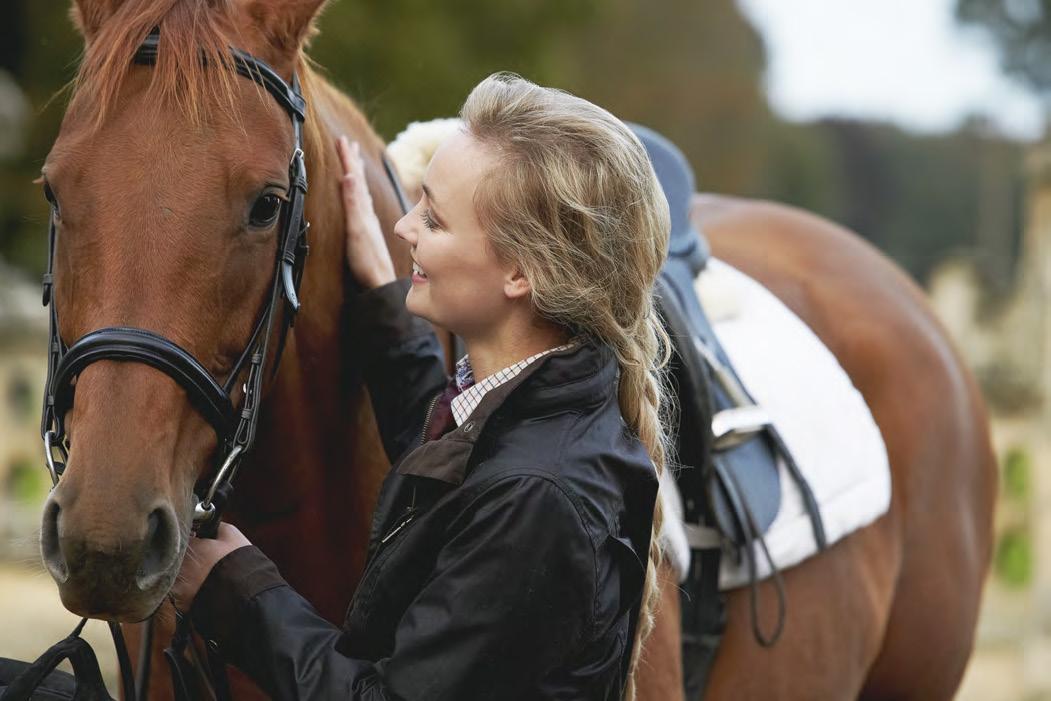








Professionally, Brooke Major is an artist. But in her heart, she is a horsewoman. She was born and raised in Atlanta, Georgia, where she discovered her love of horses while riding in the North Georgia mountains when she visited her grandparents. She started taking hunter/jumper lessons near her home and has been entranced with jumpers ever since. Horses feature prominently in her artwork, as well as in the landscapes she paints of her adopted home in Normandy, France.
“I’ve loved art ever since I was 3, and I have taken art lessons with professional artists since I
was around 5 years old,” she said. After winning accolades for her art in grade school, Major began to consider a career as an artist, a career that her parents vehemently opposed.
“I ended up getting a degree in international relations at American University in Paris, but I defied my parent’s wish for me to have a normal career and became a professional artist at the age of 21 with paintings exhibited in galleries in Atlanta, and Deauville, France.”
“I knew that I had to be original with my work in order to stand out, so I decided to sculpt titanium white oil paint to play with shadow and
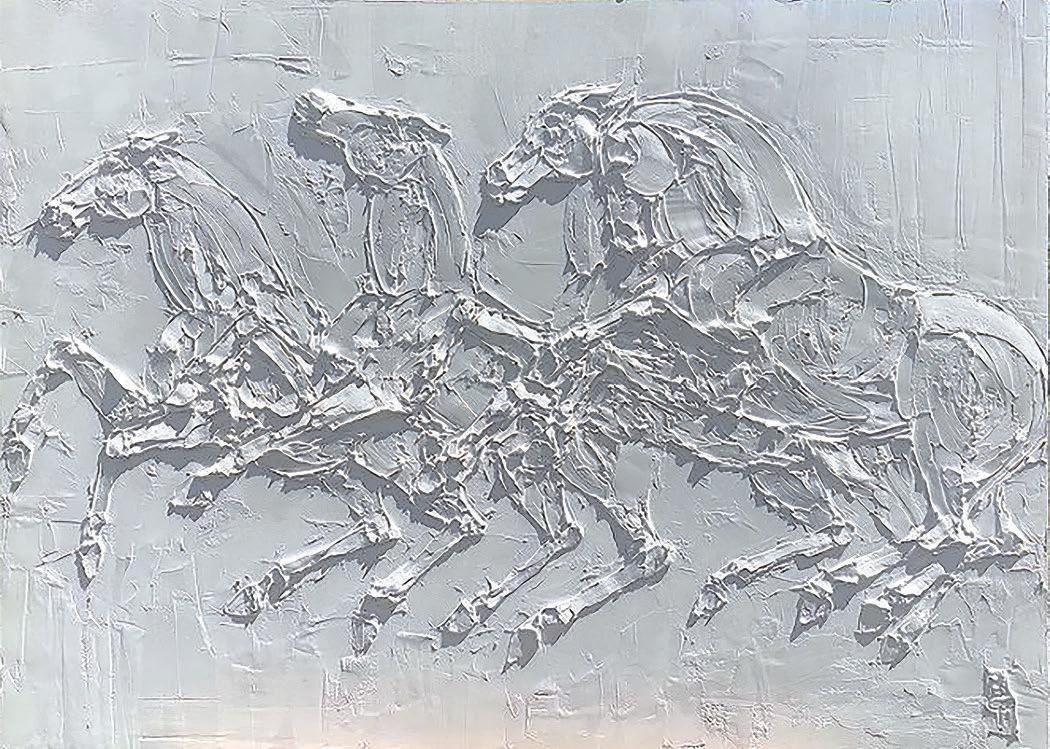
light. I started the process of sculpting inside of the paint. Years and years of the practice led me to then build up the paint in bas relief with palette knives. I have a large mixer that I use to mix drying agents to help the lengthy drying process… I then sculpt the paint until an image forms on the canvas.”
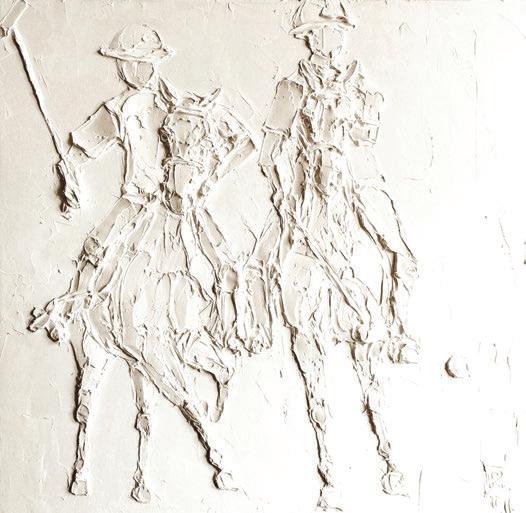

“I make all sizes of paintings to adapt to the European and American art markets but I prefer to make large canvases, three, four and five feet
(even bigger if I am permitted!) I also started doing gold and gold and black paintings during COVID, and fell in love with gold, for, like white, gold is light.”

“Horses are my stability, my heart and my soul” Major continued, “Without horses I wouldn’t have become the strong and independent person I am today.”
Major has continued to work with jumpers at her home in France, and she breeds Selle Francais and Anglo European Warmbloods with the goal of developing them for competition in the young horse classes. Major’s husband owns a dairy farm in Normandy with 250 Holstein cows, and together the couple have a 6-year-old son.
Brooke Major’s work can be found at Whiteside Gallery in Cashiers, North Carolina, where she will have a solo exhibit beginning in May of 2023. You can also find her paintings at Thomas Dean’s Fine Art in Atlanta, Georgia; at La Bottega Gallery in Laguna Beach, California and at Bee Street Gallery in Dallas and Fort Worth, Texas.
“Horses are my stability, my heart and my soul.
Without horses I wouldn’t have become the strong and independent person I am today.”


SERViCES:
• All Weather Arena Footing Installation
• Round Pen Installation
• Turf & Polo Field Installation
• Barn Pad Excavation & Installation

• Facility & Riding Arena Design Layout
• Drainage System Installation
• Laser And GPS Capabilities


• Standard Blue Stone Available
Consulting services are available for all aspects of the design and construction of your equestrian facilities. OUR PLEDGE: CB Arenas offers unparalleled peace of mind for all your equestrian facility needs.


973-222-1668
ARENAS
The Next Step in Footing




We treat ALL pets like ROYALTY Dogs, Cats, Livestock & Exotics 864-735-8502 (Ashley) www.drdo-little.com Greenville, Simpsonville, Pelzer, Fountain Inn





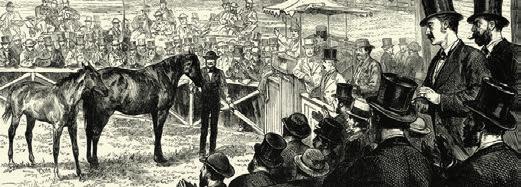


Looking forward to helping your horse stay in top shape (704) 928-7523, Dobson, NC

Servicing Davie County and surrounding area. Barefoot horses do compete at the highest levels. Optional glue on shoes for performance or transitioning. Lisa Habbley: 815-354-0765; lisahabbley@gmail.com



Chad Wilkes, huntsman for the Aiken Hounds, before the start of the Children's Hunt in the historic Hitchcock Woods, Aiken, South Carolina, January 2023. The Aiken Hounds, founded in 1914 and recognized by the MFHA in 1916, is a drag hunt and a revered Aiken tradition. Photography by Pam Gleason

PREVIOUSLY COMPLETED BUILDER’S PLAN
WOODS | BARB GOULD USKUP | | $500, $5,500 PER ACRE | 91 ACRES +/- | 30 CLEARED ACRES EAST SIDE HORSE COUNTRY | FERTILE SOIL | MAY BE SUBDIVIDED
BURKWOOD PLACE | MIKE HOSANG | 803.270.6358 | $999,000 CLASSIC RESIDENCE | 4,025 SQUARE FEET | 4 BEDROOMS, 3 FULL BATHS | JUST UNDER AN ACRE FORMER BARN & PADDOCK SPACE | GORGEOUS MATURE LANDSCAPING | STEPS FROM HITCHCOCK WOODS
HISTORIC HORSE DISTRICT | COURTNEY CONGER | 803.645.3308 | $1,425,000 2,787 SQUARE FOOT MAIN RESIDENCE | 2 CONVERTED RACE BARNS | 15 STALLS LOFT APARTMENT | DRESSAGE ARENA | DOWNTOWN HORSE DISTRICT

THREE RUNS PLANTATION | TOM MURRAY | 626.644.3008 | $765,000 TWO CONTIGUOUS LOTS TOTAL 17.76 ACRES | LOT 39 HAS 12.76 ACRES, 12x24 RUN-IN SHED, WELL LOT 31 HAS 5 ACRES, TWO 12x24 RUN-IN SHEDS w/TACK & FEED LOCKERS, 2 FENCED PASTURES


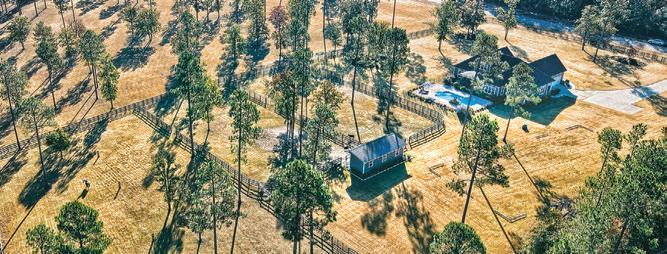

PICKETT POST FARM | BARB GOULD USKUP | 803.295.3199 | $275,000




11.33 ACRES | ADORABLE 384 SQ FT COTTAGE | OFFICE/GUEST TRAILER NEW 12x36 RUN-IN SHELTER WITH 2 STALLS | FENCED | STORAGE/WKSHP


